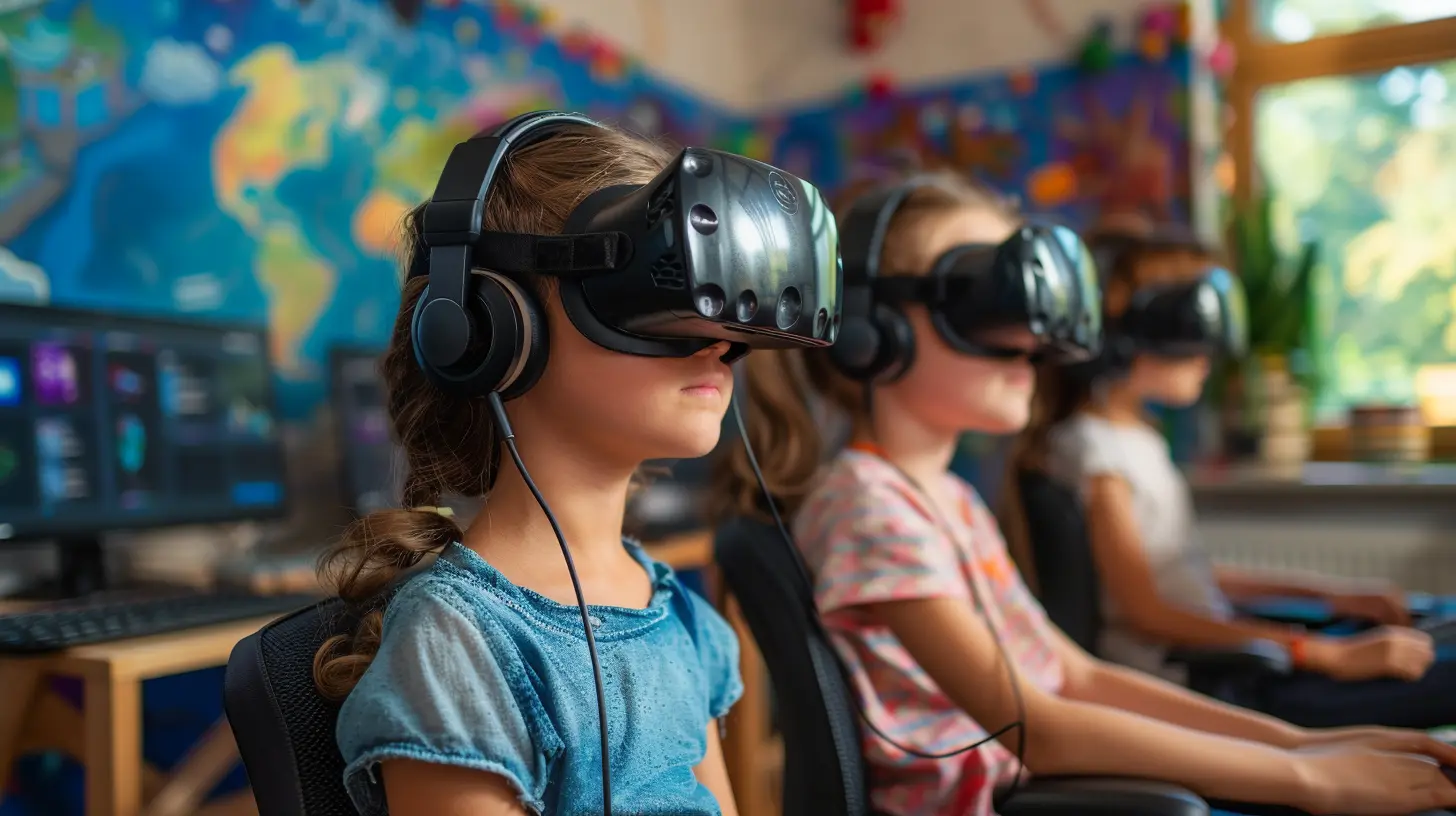Top Hacks for Personalizing Learning in Virtual Classrooms
4 November 2025
Let’s be honest—virtual classrooms are here to stay. Whether you’re a teacher trying to keep your students engaged from miles away or a parent peeking over your kid’s shoulder during Zoom class, you've likely noticed something: not every student learns the same way. Some kids light up with visuals, others need to talk things out, and a few thrive when they’re given the freedom to move at their own pace. That’s where personalized learning comes in.
In this digital age, it’s not just a nice-to-have—it’s a game-changer. The beauty of virtual classrooms is that they actually make it easier than ever to customize the learning experience. All you need are the right strategies, tools, and a little creativity.
In this post, we’re diving deep into the top hacks for personalizing learning in virtual classrooms. Get ready to level up your teaching game—or your kid’s learning journey.
Why Personalization Matters More Than Ever
Let’s set the stage. Imagine you’re trying to teach a group of 25 students how to bake a cake. But instead of giving them each a set of ingredients tailored to their diet, skill level, and kitchen tools, you hand everyone the same box mix and say, “Go!” Some will crush it, others might burn the house down, and a few will just give up. That’s what a one-size-fits-all classroom often looks like.Personalized learning, on the other hand, meets each student where they’re at. It adjusts to their interests, strengths, pace, and even mood. And when we move this from a physical classroom into a virtual one, the opportunities become endless.
Hack #1: Start with Data, But Make It Human
Data might sound dull, but hear me out. It’s not about turning your students into spreadsheets—it’s about understanding them better.Use baseline assessments, polls, or simple surveys to get a sense of where each student is. Ask questions like:
- What’s your favorite way to learn: videos, reading, games?
- Which subject do you enjoy the most?
- On a scale from “I got this” to “Please help,” how do you feel about math?
Gathering this info doesn’t just help you group students by need—it helps you connect with them. Once you know what makes them tick, you can tailor content that resonates.
🛠️ Tools to Try: Google Forms, Edmodo Quizzes, Microsoft Forms, Kahoot surveys.
Hack #2: Offer Flexible Learning Paths
Ever heard the phrase “all roads lead to Rome”? That’s the mindset you need here. The destination (learning goals) is the same, but how students get there? That’s up to them.Some learners might prefer watching a YouTube video. Others might want to read an article or play a simulation game. And a few might benefit from a one-on-one chat.
Create a "learning menu" with multiple options for each topic. Let students pick how they want to engage with the material and how they want to show what they’ve learned—be it through a podcast, a doodle, a slide deck, or even a TikTok (yes, seriously).
🏃 Pro Tip: Build choice boards or hyperdocs that let students move through content at their own pace and style.
Hack #3: Use Adaptive Learning Technology
Personalization doesn’t mean you have to do everything manually. There’s an entire world of adaptive learning software that does the heavy lifting for you.These platforms use algorithms to assess student performance and automatically adjust content difficulty. Think of it as a GPS that reroutes based on how the student is doing.
🧠 Top Picks:
- Khan Academy (for self-paced math mastery)
- DreamBox (adaptive for K-8 math)
- Duolingo (language learning that feels like a game)
- Smart Sparrow (interactive higher-ed learning)
The key here is that students aren’t stuck. If they struggle with a concept, the system evolves. If they’re breezing through, it offers tougher challenges.
Hack #4: Build in Personal Conferences
Technology is awesome, but human connection still wins. Schedule short 1-on-1 video chats with your students. Not to lecture them—but to listen.Ask them how they’re doing, what’s working, what’s not. These check-ins build rapport, boost motivation, and give you insights that no quiz can provide.
Think of it like a coach having a quiet moment with a player on the bench—sometimes that’s when the magic happens.
🗓️ When to Do It: Weekly for younger students or monthly for older ones. Keep it relaxed, under 10 minutes.
Hack #5: Gamify the Experience
Let’s not pretend students are logging into their virtual classrooms with the same excitement they have for Fortnite or Roblox. But what if learning felt more like a game?Gamification adds points, levels, challenges, and even badges to the learning process. It taps into that dopamine-driven reward system we all secretly love.
🎮 How to Gamify Learning:
- Award badges for completing tasks
- Create leaderboard challenges
- Use platforms like Classcraft or Quizizz
- Let them "unlock" bonus content
This isn’t about turning school into a full-blown video game. It’s about leveraging the same psychological triggers that make games so addictive—and using them for good.
Hack #6: Create Personalized Feedback Loops
Generic comments like “Great job!” or “Needs improvement” won’t cut it anymore. Students need feedback that’s timely, specific, and encouraging.Even better? Make it two-way. Encourage students to reflect on their work and respond to your comments. This pushes them from passive receivers to active learners.
📝 How to Get There:
- Use video feedback tools like Loom or Flip
- Set up private comment threads in Google Docs
- Ask students to self-assess using rubrics
The more personalized your feedback, the more you show that you see them. That’s powerful.
Hack #7: Tap Into Interests and Passions
Let’s get real—when students care, they perform better. So why not tailor lessons around what they love?If Jimmy is obsessed with basketball, use sports stats for math problems. If Priya lives for TikTok dances, let her choreograph a routine to explain a science concept.
Whatever the curriculum, there’s always a way to connect it back to a student’s world. It just takes some digging—and a little imagination.
💡 Idea Bank:
- Research projects based on personal interests
- Open-ended assignments with flexible formats
- Use current pop culture or trending topics in lessons
Remember, personalization isn’t always about tech. Sometimes, it’s just about caring enough to find that spark.
Hack #8: Encourage Peer-to-Peer Learning
Personalized doesn't mean isolated. Sometimes, the best way to learn is from each other.Set up virtual study groups or breakout rooms where students can teach one another. Peer interactions build confidence and deepen understanding—plus, they bring a much-needed social element to remote learning.
👥 Try This:
- Assign “peer buddies” for collaborative tasks
- Host virtual “teach-back” sessions
- Use platforms like Padlet or Flip for shared reflections
It’s like building a digital learning village where everyone helps everyone climb.
Hack #9: Use Visual Learning Maps
Even the most independent learners need a sense of direction. A personalized learning map shows students where they are, where they’re going, and what steps they need to take.Think of it like a GPS for your classroom. Kids can track their progress, choose alternate routes, and celebrate destinations (a.k.a. mastering a topic).
📍 DIY It: Use tools like Trello, Google Sheets, or Notion to create interactive checklists or progress boards.
Visuals make abstract goals feel concrete. And when students can see their learning journey, they’re more likely to stay on course.
Hack #10: Be Flexible With Time
Here’s a hot take: Learning doesn’t have to happen between 9 AM and 3 PM.One of the biggest benefits of virtual classrooms is flexibility. Some students focus better in the evening. Others need a midday break to walk the dog or clear their head.
So why not lean into that?
🕒 Options to Offer:
- Recorded lessons for on-demand review
- Extended deadlines (within reason)
- Independent learning days
By embracing flexible timing, you’re respecting students’ unique rhythms—and that’s the heart of personalization.
Final Thoughts: Personalization is a Mindset
At the end of the day, personalizing learning in virtual classrooms isn’t just about cool tools and digital tricks. It’s a mindset. It’s about seeing each student as an individual with unique needs, dreams, and quirks.And while it might sound overwhelming, start small. Try one or two hacks from this list. See what clicks. Adjust. Keep going.
Because when students feel seen, heard, and valued, they don’t just learn—they thrive.
all images in this post were generated using AI tools
Category:
Virtual ClassroomsAuthor:

Zoe McKay
Discussion
rate this article
1 comments
Wade Harmon
Essentials overlooked: student choice matters.
November 10, 2025 at 3:26 AM


